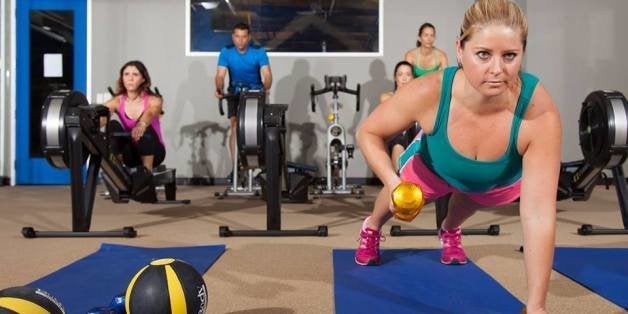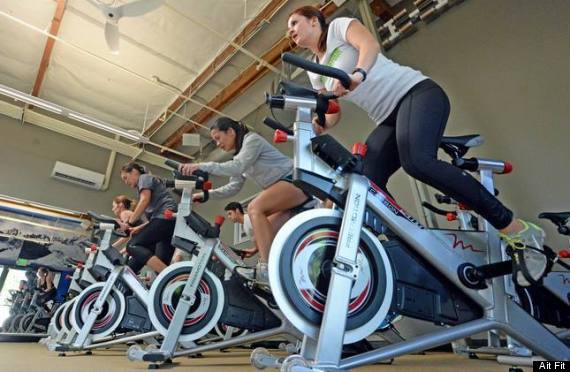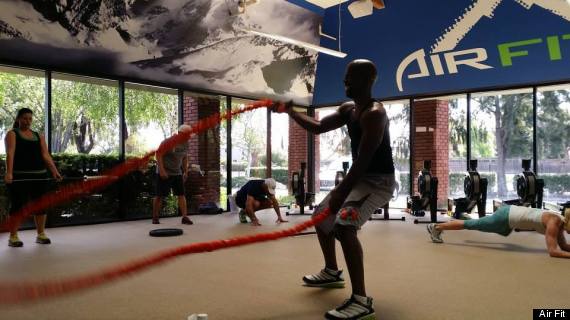
What We Tried: AirFit, an indoor exercise studio that pumps oxygen-depleted air into the classroom to simulate high-altitude atmospheres for yoga, circuit training, cycling and rowing.
Where: Pleasanton, California. The AirFit studio is located in The Quad, which is a larger facility that also has a weight lifting space, barre exercise studio and CrossFit gym.
For How Long: Each class is about 50 minutes long.
How'd It Feel: It feels like the first time. No, really. Remember when you decided you wanted to get in shape for the first time, and then you put on some sneakers and went for a jog around the block? And after two minutes, your head started pounding and your heart felt like it was going to jump out of your chest?
Yeah. That's what working out in an AirFit studio feels like. I took two classes there: circuit training and yoga. During the circuit class, it didn't seem to matter how many hundreds of burpees I'd done in the past, because doing it at "10,000-feet altitude" meant I was back at square one. In addition to burpees, we did sprints on the bike and rowing machine, shoulder presses, V-crunches, plank variations and skipped (a functional fitness favorite). At a normal fitness studio, I would have hopped from one to the other with no problem. But at AirFit, I needed to sit down, sip my water, talk to the instructor -- anything that would give me a break in between sets.

Photo courtesy of AirFit / Facebook.
For the yoga class, I took my mom and aunt with me and evilly "forgot" to tell them exactly what they were getting into. I wanted to see what their reactions would be, and we conveniently arrived late so they didn't get to hear the teacher's spiel about the air. After the class, my mom, who practices yoga regularly, said she actually found it a lot easier to breathe in the class -- perhaps because the depleted oxygen forces you to concentrate on your breath, making each inhale and exhale intentional. It's, you know, the whole point of yoga, so I'm not surprised it was deeply relaxing for her. My aunt, who doesn't practice yoga, says the class left her with a headache. So be warned.
What It Helps With: Altitude training has long been a strategy for professional athletes who want to gain an edge on their competitors. If you train carefully at high altitudes for long enough, your body will increase its number of red blood cells, and those blood cells will be more efficient at bringing oxygen to your muscles. Then, when it comes time to perform at normal altitude, you've got more red blood cells -- and more efficient ones -- than those who didn't train high above sea level. The effect only lasts for about two weeks, but for some athletes, it's enough.
At AirFit, the average class is around 10,000 feet -- the altitude that some professional athletes train at. To approximate the lower atmospheric pressure at high altitudes, the oxygen levels at AirFit go from 20 percent to around 14 or 15 percent oxygen, and could cause people to feel nausea, headaches or thirstiness.
Carlo Maravilla, the director of AirFit, says that his studio has features that make it a lot safer than true altitude training. For one, if you start to feel queasy, you can just exit the studio. It's an easy enough safety measure, as opposed to true altitude training that would require you to slowly scale back down a mountain for perhaps hours at a time.
Secondly, heart rate monitors are available for purchase at the desk, and the chest straps transmit your heart rate to big TV screens in the studio for the instructor to monitor at all times. Finally, AirFit might also offer an advantage to those with runner's knees or other joint pain. Because the low-oxygen levels put your body on notice almost immediately, you don't have to work out as long or as hard as if you were in a normal studio.
"It saves your joints and ligaments," says Maravilla. "With fewer repetitions, you're still getting an equally intense workout."
What Fitness Level Is Required: All fitness levels are welcome, although true beginners might find that exercise at any old atmospheric levels will give them that lung-burning, head-pounding, air-gasping feeling. Maravilla also teaches a two-hour triathlon class on Saturday mornings for people who want to use the higher altitude to jumpstart their training.
What It Costs: A single class starts at $20.
Would We Go Back: Yes! This class made me feel a pang of nostalgia for when I first started working out. It's difficult to keep pushing myself to the next level of fitness and easy to get complacent with the same old workouts and the same (more likely, less) level of effort. Simply stepping into this room made me hurt like I haven't experienced in a long time, and it felt good.

Photo courtesy of Air Fit / Facebook.
CORRECTION: A previous version of this post incorrectly stated that the percentage of oxygen at sea level differed from the percentage of oxygen at 10,000 feet, when in fact the change in atmospheric pressure is what accounts for breathing difficulties at high altitudes.